


|

|
WHAT KIND OF TELESCOPE? |
| BACK | HOME |
THE REFRACTORRefractor History A Dutch optician (someone who makes lenses for glasses), Hans Lippershey, designed the convex lens for the first refracting telescope in 1608. He found that a distant object appeared to be much closer when he looked at it through a concave lens and a convex lens held in front of each other. He put the lenses into a tube to make the first refracting telescope.  Galileo Galilee made the first refracting telescope used to study space in 1609. He used it to discover the four largest of the moons orbiting Jupiter. Galileo also used his refracting telescope to map mountains and craters on the surface of the moon, confirmed the phases of Venus, observed and analyzed sunspots, and misidentified the rings of Saturn as two bodies on either side of the planet which confusingly disappeared from time to time, as well as discovering that the Milky Way, thought at the time to be nebulous, was actually a multitude of stars packed so densly that they appeared to be clouds to the naked eye. Galileo could see objects 20 times smaller than the human eye could using his telescope.  This (above) is what most people not famliliar with astronomy think of when you mention the word "telescope". A lens at one end of a tube, with the eyepiece and focuser at the other end, on a tripod mount of some kind.  A refracting telescope works just like a magnifying glass. It uses a convex glass lens (to bend light and bring it into focus. This lens is thicker in the center than it is toward its edges, which bends the light more at the edge of the lens than light coming through the center. This allows all of the light to come together at a focal point. The point of focus is where the image is created.  If someone looks into the telescope eyepiece, another concave lens at the opposite end of the telescope tube, it magnifies the image which is at the point of focus. Similar to how a standard magnifying glass magnifies print on a page in a book.  Refracting telescopes have two main problems however — images are not always clear because the light is being bent through the glass creating a prism effect, and the physical size of the lens is limited (which limits the light gathering power of the telescope). In a refractor, light has to pass THROUGH the glass material, therefore in order to get good quality, bright images in the telescope, the glass has to be as pure and free of defects, free of air bubbles, and free of inclusions (particles of matter or minerals which are not the same translucense as the glass material) as possible. This was, and still is, somewhat difficult (e.g. expensive) to do even with todays glass manufacturing methods. These defects reduce the overall light gathering ability of the lens by blocking small amounts of light passing through the lens. Also, the lens material has to be polished to a high degree of accuracy so that all of the light will focus to a point. Unfortunately because light is not one color but a combination of the rainbow of colors, this presents another problem. Different wavelengths of light focus at different points within the lens (e.g. a prism separating light into a rainbow). This creates a phenomena called chromatic aberration (or literally - "color distortion"). 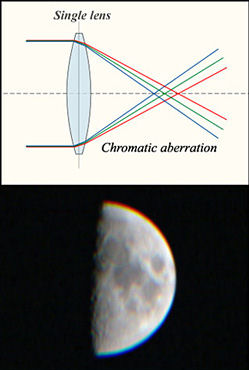  By adding a second plano-convex (convex on one side, flat on the other) lens to the back of the concave lens, the distortion can be reduced significantly, but not eliminated. This type of lens combination is called an achromatic (literally - "without color") lens. This is what is found in most modern refracting telescopes. Even with expensive and precision made lenses, the larger the lenses get, the problem of color distortion still creep into images making fine details look fuzzy and rainbow-ish which reduces image quality. As lens size increases, these two problems start to increase exponentially, making the precission manufacturing of large refracting lenses very expensive and difficult. The largest currently-functioning refracting telescope is at the Yerkes Observatory - its objective (main) lens is 40-inches in diameter (102 cm). One more problem with refractors is that in order to introduce the least amount of distortion and chromatic aberration into the optical system, the lens makers had to keep the curve of the lens to a relatively shallow curve. This increases the distance at which the light waves converged to a point, e.g. the focal length. This means that the telescope tube becomes longer as you increase the lens' light gathering power (aperture). The result is shown in the images below. Relatively weak telescopes (by reflecting telescope standards) becoming huge behemoths just to get more light gathering power.  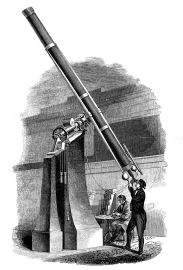 THE REFLECTORReflector HistoryA Scottish astronomer, James Gregory, came up with the design for the reflecting telescope in 1663 but a working model was never successfully built. However, the famed scientist, Isaac Newton made the first working model of the reflecting telescope in 1688. The design hasn't changed much at all in 300+ years, except maybe for the mount.  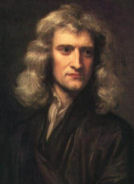 Newton built his reflecting telescope because he suspected that it could prove his theory that white light is composed of a spectrum of colors. Color distortion (chromatic aberration) was the primary fault of refracting telescopes of Newtons day and there were many theories as to what caused it. During the mid 1660s while working on his theory of colour, Newton came to the conclusion that this defect was caused by the lens of the refracting telescope behaving the same as prisms he was experimenting with, breaking white light into a rainbow of colors around bright astronomical objects.  If this was true then chromatic aberration could be eliminated by building a telescope that did not use a lens but instead used a mirror, a reflecting telescope. In late 1668 Isaac Newton built his first reflecting telescope. He chose an alloy (speculum metal) of tin and copper as the most suitable material for his objective mirror. He later devised means for shaping and grinding the mirror and may have been the first to use a pitch lap to polish the optical surface. He chose a spherical shape for his mirror instead of a parabola to simplify construction, even though it would introduce spherical aberration, it would still correct chromatic aberration. He added to his reflector what is the hallmark of the design of a "Newtonian telescope", namely a secondary "diagonal" mirror near the primary mirror's focus to reflect the image at 90° angle to an eyepiece mounted on the side of the telescope. This unique addition allowed the image to be viewed with minimal obstruction of the objective mirror  The reflecting telescope is the telescope type most popular with professional and amatuer astronomers today. Like the refractor, there is a tube, but instead of lenses there are two mirrors (a primary at the bottom of the tube and a secondary flat diagonal mirror near the top), then a focuser and eyepiece, usualy on a dobsonian mount, but can be on a tripod, fork or other equatorial-type mount.  A reflecting telescope uses a primary convex mirror which is curved to a parabola shape to bend all of the light into a single point at some distance from the surface of the mirror. This single point is called the focal point. The distance from the mirror surface to the focal point is called the focal length. 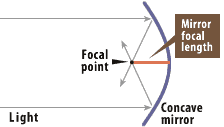 Mirrors are usually designated by the diameter of the mirror itself and the focal length of the mirror's curve. Dividing the focal length by the mirror diameter gives the f-ratio of the mirror (usually written as f/8, f/6, f/4.5, etc.). Likewise multiplying the f-ratio by the mirror diameter gives you the focal length. You'll see this information listed on most commercial reflecting telescopes. Example: A 6-inch f/8 mirror is a 6-inch diameter mirror with a focal length of 48-inches from the mirror's surface. Because reflectors are only bouncing light off of one surface of the glass mirror, the optical quality of the glass underneath the reflecting surface is not of much concern. Light will not be passing through the glass so the problem of inclussions and chromatic aberration do not cause a problem. This frees up the telescope makers to increase the size of the mirrors significantly. And remember, aperture size is key to getting brighter and clearer images from a telescope. In fact, the largest optical telescopes in the world all use mirrors, including the Hubble Space Telescope. At present the largest reflecting telescope in the world is the 387-inch (982-cm) Keck telescope at Mauna Kea Observatory in Hawaii. Since the primary mirror is bouncing the light directly back onto itself to a single point within the mirror's field of view, as soon as you try to put your eyepiece, and thus your head, at that point you block the light hitting the mirror, consequently blotting out the thing you are trying to see. The phrase I heard growing up comes to mind, "You make a better door than a window!" Meaning I was blocking someone's view of something.  A secondary flat mirror is needed in order to bounce/bend the light at a 90 degree angle so that the focal point is now outside the main path of the primary mirror. Then we can place an eyepiece there to see the image. 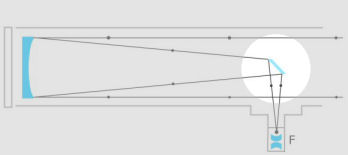 THE CATODIOPTRIC A telescope that uses a combination of mirrors and lenses to increase the effective focal length of the telescope while allowing it to be folded into a more convenient and compact size. The use of a full-aperture correcting lens in these scopes virtually eliminates spherical aberration, chromatic aberration, and coma. The word catadioptric is derived by combining the term for an optical system that forms images by using mirrors (catoptric) with the one for a system that uses lenses (dioptric). The most popular catadioptric designs are the Schmidt-Cassegrain and Maksutov-Cassegrain. Schmidt-Cassigrain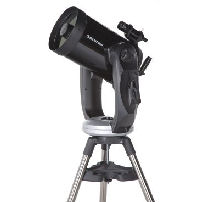 The Schmidt-Cassegrain design is very popular with consumer telescope manufacturers because it combines easy to manufacture spherical optical surfaces to create an instrument with the long focal length of a refracting telescope with the lower cost per aperture of a reflecting telescope. The compact design makes it very portable for its given aperture, which adds to its marketability. Their high f-ratio means they are not a wide field telescope like their Schmidt camera predecessor but they are good for more narrow field deep sky and planetary viewing.  Maksutov-Cassegrain The focal ratio of the Maksutov-Cassegrain design provides high powers and a narrower field of view. This makes them unsuitable for wide-field astrophotography but superb at lunar and planetary imaging. They are also very adept at imaging tightly packed formations such as globular clusters and at splitting double stars. Maksutov-Cassegrain telescopes have been sold on the amateur market since the 1950s. Most early models were small run prestige models that were very expensive. The mid-70s saw the introduction of mass-produced models by some of the major commercial manufacturers. More recently low-cost Russian and, lately, Chinese mass-production have pushed the prices down even farther. Today the design has become a popular choice for the amateur astronomer, if not a 'telescope for the masses', something unthinkable in the 60s when even small Maksutov-Cassegrains such as the 'Questar 3.5' were quite expensive and within the reach of deep pockets only.  THE TELESCOPE MOUNTThe telescope mount is usually a secondary consideration, if that, by most people buying their first telescope. But just like the motor is the usual point of focus on a race car, the tires are the telescope mount of the raceway. People who aren't already involved in the hobby, just don't think of the mount as being JUST as important as the optical system. You can spend all your money on the greatest optics and mirrors you can buy, and place it all on a wobbly, spindly, light-weight mount and have the equivalent of an indy car on bicycle wheels!  Not winning any races! The mount is what holds the telescope and is used to position the scope to point to locations in the sky. It can be a simple transportable tripod, an altitude-azimuth dobsonian or a huge pier set in concrete, and a few other designs in between. 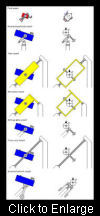 The main feature of a mount should be stability. It doesn't matter which design you choose for your telescope mount. However, if your telescope wobbles around after you touch it to adjust something or if a stiff breeze blows across it, you'll have to wait several seconds for it to stop wobbling before you can observe anything in it. And trust me the wind can really be your enemy if you have a weak spindly mount. Most store bought telescopes who advertise their telescopes using the magnification power as the descriptor for the scope usually fall into this wobbly mount category. If the mount looks and feels like it could hold up the end of a jacked up pick-up truck then it probably is fine. If not, stay away from it and don't waste your money! The next thing to consider with a mount is what you will be using it for. Will you be casually observing from object to object each session night? Will you want to track objects so you can hook a camera to your telescope to take pictures? Will you be planet observing for long periods? Do you want a quick setup-and-go telescope? These are the things that will determine what kind of mount will work best for you. Equatorial Mounts (RA/DEC)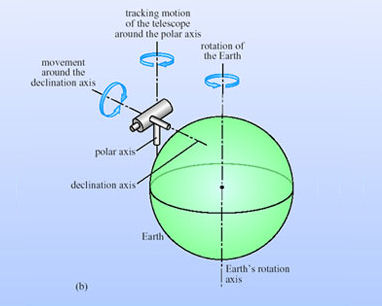 To keep an astronomical object within the field of view, telescopes need to be able to compensate for the Earth's rotation. Some telescopes use an equatorial mount, which allows the telescope to track an object along a parallel to the celestial equator. The polar axis (green arrow) is pointed at the north celestial pole; its angle to the horizon is the same as the observer's latitude. Once the telescope mount is aligned to the pole, the right ascension (r.a.) and declination (dec.) are adjusted to match the celestial coordinates of the object. As a result of the Earth's rotation, the right ascension coordinate drifts across the sky along a path parallel to the celestial equator. Once the telescope is adjusted to point at an object's sky coordinates (right ascension and declination), it is simply a matter of driving the right ascension axis with a motor to keep up with the object as it moves. Altazimuth Mounts (Alt/Az) Alazimuth mounts move on the altitude (up/down - 0° to 90°) and azimuth (left/right - 360°) axes, making them useful for both terrestrial and astronomical observing. They are an attractive option for their simplicity of operation and intuitive pointing, but are not suitable for astrophotography. This type of mount is a favorite with many amateur astronomers because it is relatively easy to manufacture and therefore inexpensive to buy or build. This cost savings translates into being able to buy larger aperture optics and therefore getting more resolution for less money than an equivalent sized equatorially mounted telescope. The larger types of altazimuth mounts are affectionately called "light buckets" because of their wide tube shape and huge light gathering ability. When used with an astronomical telescope, the biggest advantage of an alt-azimuth mount is the simplicity of its mechanical design. The primary disadvantage is its inability to follow astronomical objects in the night sky as the Earth spins on its axis the way that an equatorial mount can. Equatorial mounts only need to be rotated about a single axis, at a constant rate, to follow the rotation of the night sky (diurnal motion). Altazimuth mounts need to be rotated about both axes, at variable rates, and they also impart a rotation to the field of view.  Dobsonian Mount The most popular altazimuth mount is known as a Dobsonian mount, named after the inventor and sidewalk astronomer, John Dobson from San Francisco. This design consists of a simple base with sliding pads (usually of teflon or nylon) that the rocker cradle, which holds the telescope tube, rests on and rotates around a 360° axis (compass points). The telescope tube's altitude axis rotates purpendicular to the azimuth axis from 0° (parallel to the ground) to 90° (straight overhead).
Other MountsMost other telescope mounts are variations of the two mentioned above. They either have one axis aligned with the pole or are an alt-azimuth system. Because larger mirrors are heavy, it is difficult to build large equatorial mounts for reasonable costs, so alt-az mounts tend to be seen more for larger research grade scopes. Computer controls make up for the lack of polar alignment so the disadvantages of alt-az mounts are negated. The examples below are mostly variations on equatorial mounts. Equatorial or polar alignment is the ideal for long term viewing or photography. So there have been many more variations on how to design these types of mounts than a simple alt-az mount.  Fork Mount Fork Mount - Fork mounted telescope are one of the more common alt-az mounts as well. These are usually seen on SCT type telescopes. Because these telescopes are shorter than a standard newtonian telescope, the mount can be reduced to the very minimum support which is best manifest in the fork-mounted form. This allows access to the telescope tube without having a rocker body getting in the way. 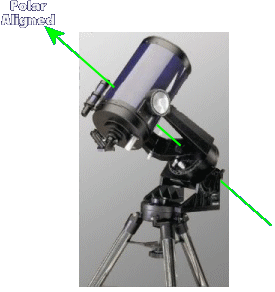 Equatorial Fork Equatorial Fork - The equatorial fork is a variation of the fork mount. This mount simply tilts the alt-az fork mount so that the azimuth axis is pointing so that it becomes polar aligned. For most SCT scopes, this tilted section of the mount is known as an equatorial wedge. The direction of movement that used to be Azimuth (left-right) is now Right Ascension, and the direction that used to be Altitude (up-down) is now Declination.  Horseshoe Mount Horseshoe Mount - This type of mount, as well as the English, or Yoke Mount, are extensions of the fork mount for larger, heavier telescope tubes. The fork is extended forward and then joins to either a horseshoe shaped front piece, or is boxed off at the axis point. The horseshoe forward axis, is a split ring which allows the tube to lie directly in line with the polar alignment while still being supported at the front end of the mount.  English/Yoke Mount English Yoke - By boxing off the forward axis of the English/Yoke mount, this blocks from view anything at the polar regions because the mount is now in the field of view when the telescope is pointed there. Yet this mount is extremely sturdy for large scope. The Horseshoe and English yoke mounts are also more for permanent-location mounts since latitude adjustments are more difficult to change due to the size of the mount. 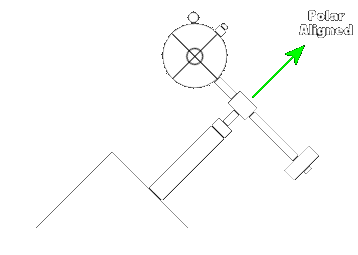 Astrographic Mount Astrographic Mount The Astrographic mount is a German Equatorial, but with the axis pointed to the North Pole on a pillar which is tilted in the same direction. This avoids a problem with the German Equatorial, where the vertical pillar blocks the motion of the telescope when following stars north of the point directly overhead (the zenith) as the Earth rotates. 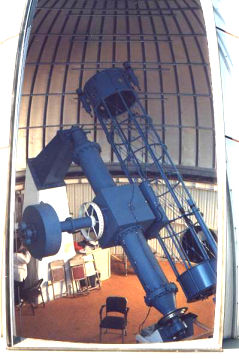 Cross-Axis Mount Cross-Axis Mount The cross-axis mount uses a long axis, braced at both ends. This improves the rigidity of the mounting, and also avoids the blockage found in the straightforward German Equatorial. Inverted-Fork Mount The inverted-fork mount is a design sometimes recommended for a beginner's first telescope with an equatorial mounting. As we can see from the diagram of different types of mountings, which shows two views of each type of mount from the same direction, but with the telescope rotated to two different positions, it can be regarded as a development of the Astrographic variation of the German Equatorial. The pivot point is the same, but now the telescope is above the pivot point instead of to one side of it, and the counterweights are moved correspondingly.   Siderostat/Heliostat Siderostat This type of mount is an apparatus consisting essentially of a mirror moved by motors so as to throw the rays of the sun or a star in a fixed direction (usually toward a screen or telescope); -- a more general term for a heliostat used to observe the sun. The National Solar Observatory at Kitt Peak is a siderostat type telescope.  National Solar Observatory - Heliostat (click to see diagram) |
 |
Send emails to: webmaster@fortworthastro.com |
FWAS is a member of the Astronomical League. The world's largest federation of amateur astronomers. |
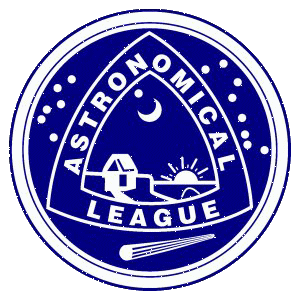 |